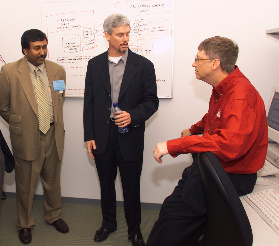 |
|
iMahal:
But about this time you moved from consulting into a real entrepreneurial
venture, no?
Roy:
Yes. With this growing consulting business, I made a lot of relationships
with people in the printing industry, working on the software side. But then
something interesting happened when I let my curiosity seek out a new
opportunity. There I was in a print shop and I'm looking at the printing
process and find out that the highest paid guy is the ink mixer. He looks at
the color combinations, mixes the ink, paints the rollers, and runs sheets
after sheets. And the guy would come from the high-tech company, look at the
As I continued to work with other offset printing companies, I found an Indian guy who was running a print shop, doing the mixing himself. He was proud of his mixing skills, which lowered his waste from 18% to 14%. He was happy with 14%. So I started talking to him about what my thoughts were. With a computer program I suggested to him how he could calculate how to mix the inks. I suggested I put together a program to see how it works. He said, "That would be great!" So I gathered all the feedback and information I needed. Then I got together with a couple of friends, and we built this application and perfected it in about 60 days. We began using the application in this print shop and others. After 4 months they told me the waste was down to 4%. We are talking about 10% savings. And the printing industry was almost going under, making maybe 3% profit. All of a sudden they are making 13% profit. As you can imagine, this application sold like hotcakes. So I got the copyright and then the patent for the application, and I was thrilled. From there the technology was acquired by a company that paid me handsomely. It made me a millionaire. My first million! That was my first entrepreneurial success.
Roy: True. My next entrepreneurial venture started when I was made an offer by a company called Inprint. They wanted to come out of offset printing, they were using my application, and they wanted me to do more solutions for them. We eventually sold Imprint to American Reprographics Company, ARC. In the meantime, because of the dot-com mania, I thought, "Am I missing out on something here?" So I got involved and built an e-commerce server. We used my money and Imprint's money, since the sale of Imprint gave us a lot of money. I hired 10 people and built up a business named MirrorPlus. Then I saw companies going public, i2, Ariba, and lots of others, all who had e-commerce servers. We were doing well enough, many small shops and printing shops were customers for my e-commerce servers, as well as large companies such as Lucent. My sales went up to $1.5 million. That's when I thought, this Reprographics company that bought Imprint might be willing to invest in us. We had some things in common. I was thinking about going IPO. So I called the CEO of ARC and convinced him to invest in the company. They did. But when the dot-com boom turned into the dot-com bust, ARC came to us with something unexpected. They needed more technology development, so they wanted to invest more money in us, with our technology focused on their business.
This new focus actually brought Bill Gates here on a visit. He was supposed to stay only 5 minutes but stayed 45 minutes. We were using Microsoft technology and I had at that time 1 million drawings stored in an SQL database. At that time, nobody would dare do that. Everyone typically went with Oracle. After seeing everything Mr. Gates said, "Mr. Roy I have never seen such a gutsy entrepreneur." That was the best compliment I had ever received. And then people like Michael Dell came down as we became popular.
|
 |
|
 |
|||||

